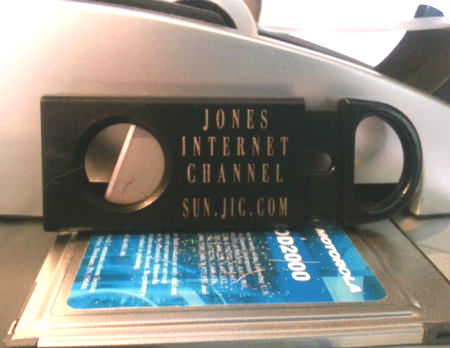When Cable Broadband Was a ‘Channel’
I recently completed a cross-country move and, during that process, came across a lot of stuff I had long forgotten I had, including some cable tchotchkes from days of yore.

One such item was a cigar cutter from Jones Internet Channel that, if memory serves, was distributed at a cable event from the mid/late 1990s… maybe the National Show or the now-defunct The Western Show. I’m sure the marketing concept here was about it being a cutting-edge service, and I think Jones Internet Channel was trying to get other cable operators to join its program.
But, man, look at that creaky URL!
Jones Internet Channel, for those who don’t remember, was once the brand of a high-speed Internet service that Jones Intercable launched in the 1990s by industry pioneer Glenn R. Jones, who, sadly, died earlier this year. And it looks like the brand is still being used, representing the unit that “manages online technology and services for the Jones companies.”
And Jones Internet Channel was a beacon of controversy back then, as a U.S. District Court ruled that the MSO had violated a shareholders’ agreement (with BCI Telecom Holdings of Canada) by launching the service without the approval of independent directors that sat on its board at the time. Jones, which later was sold to Comcast, tried to appeal the ruling, but ultimately signed on as an affiliate of @Home Networks, the old (and long gone) ISP that was once backed by several major MSOs and went through many waves of contention in its own right.
So Jones Internet Channel, as an ISP, didn’t stick around for long, and the name always seemed like a bit of an odd duck. But it was technically accurate – back then, and up through DOCSIS 2.0, cable high-speed service (the downstream, anyway) was delivered over a single 6MHz-wide QAM channel that provided about 40 Mbps of total capacity.
That single-channel approach was succeeded by DOCSIS 3.0 and channel bonding, initially giving cable enough capacity to chase down the speed benchmark of the day -- 100 Mbps. Today, top of the line D3.0 chips bond up to 32 downstream and 8 upstream channels, offering enough downstream capacity to push past 1 Gbps. Jones Internet Channels?
The smarter way to stay on top of the multichannel video marketplace. Sign up below.
And now with DOCSIS 3.1 and its multi-gigabit capabilities on the horizon, the use of bonded 6MHz channels will eventually (but not for a long time) be replaced by the use of blocks of bandwidth filled with tiny bandwidth-efficient OFDM subcarriers. So, in a sense, DOCSIS will become channel-less.
But the name Jones Internet Channel sure seems even more appropriate now than it did back in the day. Then, usage centered on the browsing of plain, static Web pages and tapping into bare-bones email clients. Today, it’s all about managed IPTV services and over-the-top video, including waves of subscription-based on-demand offerings and a growing batch of live TV services.
The Internet sure seems to look a lot more like a “channel” now in the sense that it’s become a high-speed conduit for video, and, perhaps in one way of thinking about it, another example of Glenn Jones’s entrepreneurial spirit and vision.
